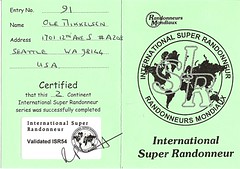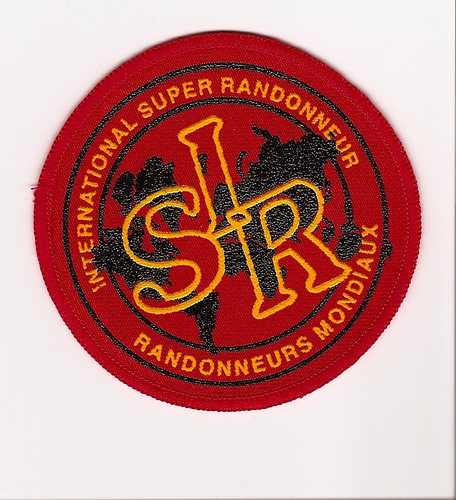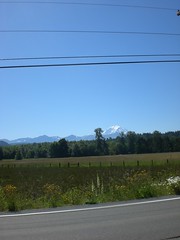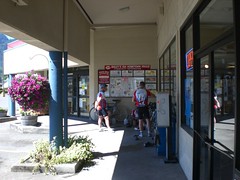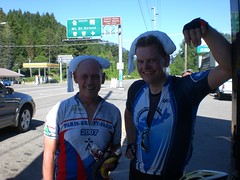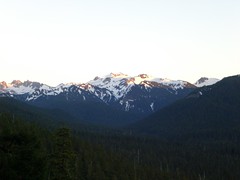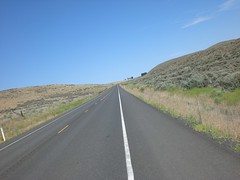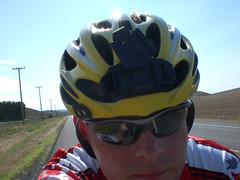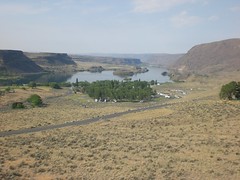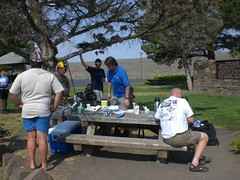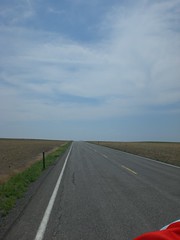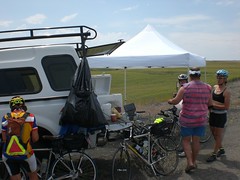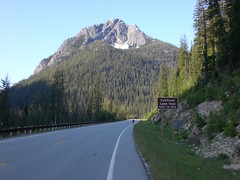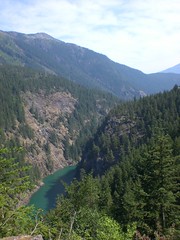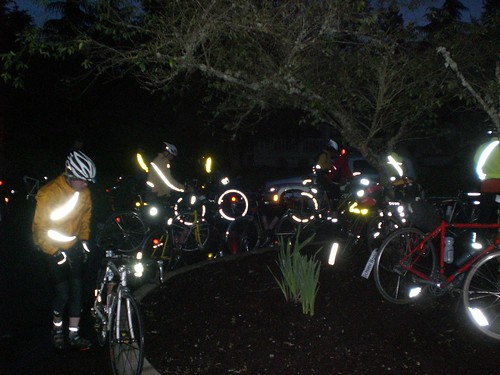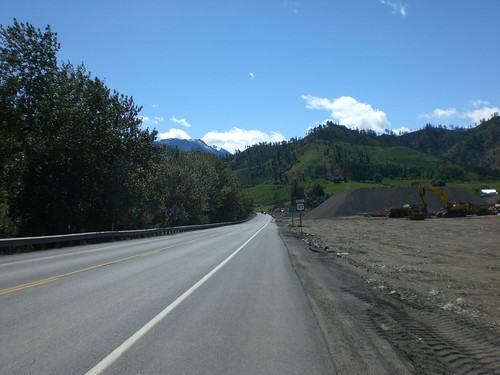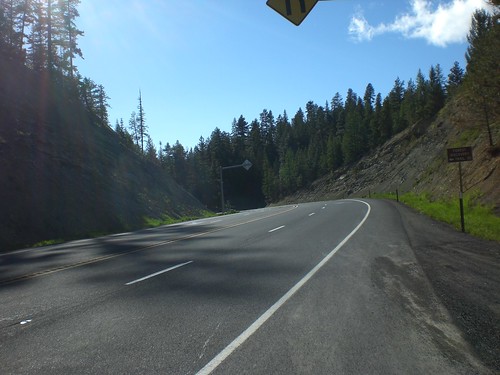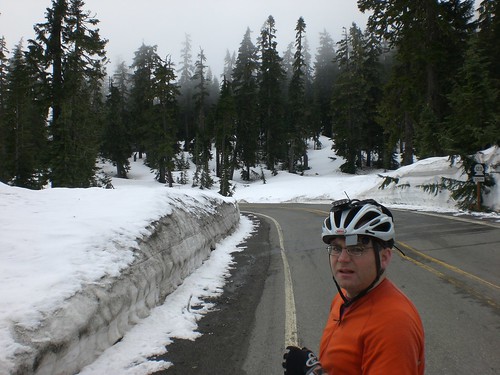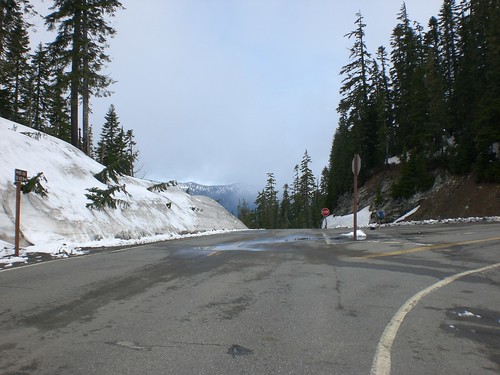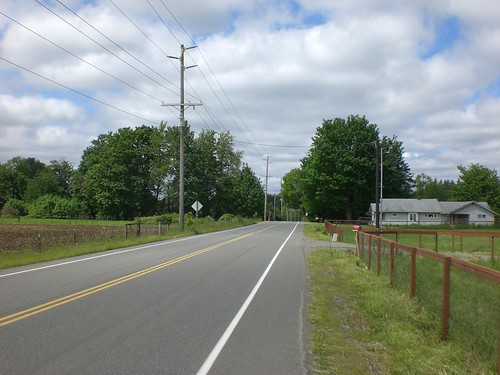
07 September 2008
New bike coming up...

My life with the web so far
May 1994: I heard about email for the first time.
January 1995: I sent my first email. I had received several before that but had no idea that our computer account names and passwords at uni were also our email usernames which we could use to access Pegasus Mail. My first email went to a high-school buddy who was in New Zealand for a year.
Shameless self-promotion (and a bit of science)!
---
The particle size distribution (PSD) of a cement powder is important for its complete characterization. From the PSD it is possible to compute the surface area of the cement powder, which has a close correlation to the rate of cement hydration. However, no international standard for measuring the PSD of cement powder has been agreed upon, and consequently a range of techniques are being used, with laser diffraction being the most common. A major inter-comparison study was completed by the US National Institute of Standards and Technology in 2004 .
Broadly speaking, laser diffraction takes advantage of the fact that forward scattering of light is principally due to diffraction, or in an intuitive way, light that went ’around the particle’. This diffracted light is not affected by the composition of the particles, only its size and shape. A small part of the light is additionally transmitted through the particle and shows up at angles beyond the first two principal diffraction peaks. This ‘transmitted’ fraction of light is affected by composition. Thus the choice of a refractive index affects the ‘large’ angle scattering, whereas the size alone affects the ‘small’ angles region of the scattered light field.
For spherical particles, each particle has its own characteristic scattering pattern, which can be computed using the so-called Mie theory. This is a completely general solution to the scattering problem for spheres, requiring only two inputs: particle diameter and the complex refractive index. Using Mie theory it is possible to compute the scattering pattern for an arbitrary size range of spherical particles.
In a suspension of particles of many sizes, the total scattering pattern is the sum of the scattering patterns that arise from each of the individual particles in the suspension. Mathematically, this can be described as:
E = K * C
Where E is a vector containing the intensity of the diffracted light in a set of solid angle ranges, K is the so-called kernel matrix and C is the volume concentration of the particles creating the diffraction pattern, i.e. the PSD. K contains information on scattering by particles of various sizes into different angles, e.g. from Mie theory. If E is measured and K is known, then C can be obtained via matrix inversion:
C = K-1 * E
A typical laser diffraction instrument consists of a laser beam that illuminates particles, and receive optics that place scattered light on a set of concentric ring detectors. Each ring detector measures scattering into a particular, small angle range. Together, the ring detectors cover a large dynamic range of angles over which the scattered light is sensed; this angle range establishes the range of size of particles that can be analyzed. There are a large number of instruments now on the market. A new version of these is made by the authors’ company, and remains the first and only truly portable laser diffraction particle analyzer (Figure 1). It incorporates 32 detector rings, covering a 200:1 angle range. The size range covered by this device spans 1.25-250 or 2.5-500 microns.

Figure 1: LISST-Portable instrument for laser diffraction of particles in liquid suspension.
The LISST-Portable instrument is provided with the option to invert angular scattering data into equivalent sphere size distribution, or into a ‘random shape’ particle size distribution. How and why this was done is explained below.
The scattering kernel, K , can only be computed if it is assumed that the particles are spherical, although lately progress has been made that enables the computation of matrices for non-spherical but regular geometrical shapes, and even irregular shapes but with limitations from computational complexity. Very few particles resulting from natural or industrial process are spheres or regular. Grinding and milling typically produces particles of a general random shape, with numerous pits and edges on their surfaces. Consequently the diffraction pattern arising from these natural, random-shaped particles can be expected to be different from spheres. Since it is not theoretically possible today to properly model the scattering from random-shaped particles we have taken an empirical approach and determined the corresponding kernel matrix, K . We have used this empirical matrix to study how the retrieval of the PSD of random shaped natural sediment particles is affected by the implicit assumption that the scattering particles are spherical, which is the current industry standard.
To construct our empirical kernel matrix K , we used our LISST (Laser In Situ Scattering and Transmissometry) laser technology to measure the scattering pattern from a range of random-shaped particles, pre-sorted into sieve size bins that were equivalent to the 32 size bins covered by the LISST–Portable instrument (2.5-500 µm for the instrument used here). We then compared these scattering patterns to those from spherical particles with the same sieve size. Sieving is only possible for particles larger than approximately 16 µm, so in order to separate smaller particles into size bins all the way down to 2.5 µm we used a density stratified settling column of known viscosity. Stratification kills all turbulence in the column and ensures that the particles settle without being affected by convection currents in the column. Thus, combining sieving and settling techniques, an empirical kernel matrix K was constructed that when used to invert observed scattering, yields size distribution of random shaped particles.
To illustrate the differences between scattering by spheres and random shaped particles, Figure 2 shows comparisons of scattering patterns from spherical and random shaped particles in two narrow size ranges: 25-32 µm and 75-90 µm. It can be seen that the peak of the scattering intensity of the random-shaped particles is displaced one to two detector bins to the left, relative to the spherical particles. Because shifting of diffraction pattern to the left implies larger size, this means that the random shaped particles, with a sieve size equal to that of spherical particles appear as if they are one size bin (18%) coarser than they actually are.

Figure 2. Measured scattering from spheres and random shaped particles, both with a sieve size of 25-32 µm (left) or 75-90 µm (right).
The implications for this are that when a laser diffraction measurement is processed, and it is assumed during processing that the particles are spherical, the resulting size distribution becomes too coarse, by approximately one or two size bin, which is 18-36% for the LISST instruments. In other words, shape effect alone implies that non-spherical particles, such as cement powders are actually 18-36% finer than reported using a Mie theory based standard laser diffraction system .
The second effect to note is that of refractive index. Cements have been analyzed with assumptions of absurdly high imaginary parts of the index, ranging from 0.1 to 1. High imaginary index implies blackness. Carbon black has an imaginary index near 0.1 so this is clearly not an appropriate value for cements. High imaginary index kills the part of light transmitted through the particle. In effect, it forces Mie theory to pure diffraction. In reality, the light that is transmitted through particles and is then actually measured, is thus interpreted to originate due to fine particles that did not exist in the suspension; in other words, assumption of high imaginary index invents fine particles.
In figure 3, we have analyzed Portland cement powder standard 114q obtained from NIST on our LISST instruments using both a spherical and a random shape particle matrix. Table 1 summarizes the D10, D50 and D90 for the two size distributions. Our spheres model employs Mie theory with assumed real index of 1.5 and 0 for the imaginary part.

Figure 3: A comparison of the size distribution obtained with an inversion with kernel matrix for spheres and for random shaped particles.
From Figure 3 and Table 1, it is clear that using a kernel matrix for random shape particles for the cement powder causes the size distribution to narrow slightly and move to the left, i.e. most of the size distribution becomes finer. We have noted that our research has shown that in general D50 (the median particle size) becomes finer by approximately 25%, which corresponds to one to two size classes for the LISST instruments. This is demonstrated here. Sequoia is the first and only company in the world to have established a laser diffraction processing protocol based on the scattering pattern of naturally random-shaped particles.
| D (µm ) | Spherical matrix | Random shape matrix |
|---|---|---|
| D10 | 5.6 | 6.9 |
| D50 | 16.7 | 15.0 |
| D90 | 36.9 | 28.3 |
Table 1. Comparison of the 10, 50 and 90 percentiles for Portland cement using the two different matrices for inversion.
To conclude, we have revisited the NIST standard 114q with an instrument that uses two advancements: an inversion for random shaped particles, and an implicit refractive index that is not as extreme as past industry practice. The new results suggest, first, that the median sizes of cements are actually a little finer than the equivalent spheres result reported in the past. And, second, that the fines reported in the past may be exaggerated by effects of both, particle shape and refractive index. Further details of this work will shortly be published elsewhere.
SSN problems
Then I went home and checked my SSN card and discovered that the number that had worked at Firestone was, in fact, the wrong one... I had been correct inititally, but the correct number had caused my application to be declined, whereas the wrong number caused my application to go through. I thought this was weird, as I know that the IRS caught me in using a wrong SSN when I filed my taxes in April - I got a letter from them saying the the supplied SSN didn't match with the one on record with Social Security for my name.
Anyway, I didn't think much about it until I tried to purchase an iPhone and problems started. I'm not up for standing in a queue, so I decided to wait until the first excitement had died down. Consequently I walked into an Apple store a couple of weeks ago, armed with SSN, credit card, ID and everything else required to get an iPhone.
Everything went slick until they ran a credit check on me and the little handheld terminal the Apple employees use started to flash bright red. The Apple guy excused himself and said he had to make a call to AT&T credit or something like that. It then turned out that the the SSN I had used in the Apple Store didn't match the one on file with Equifax, Experian and TransUnion (the 3 large credit monitors in the US) - the first 3 numbers were apparently transposed (although it was very difficult to get exact information out of the person on the other end of the line). I was told I had to go home and call Equifax and have them update my file with the correct SSN.
The next day I called Equifax and after spending 10 minutes on the phone asking loads of security questions, half of which I couldn't remember the answer to, it turned out that, indeed, they had on record a SSN where numbers 2 and 3 were transposed compared to the numbers on my card. I was then told to mail in copies of my driver license, utility bills, SSN, and other stuff, and they would fix it in 30-45 working days! I objected vigorously to the processing time, arguing that I couldn't sign up for *anything* when my SSN was wrong, but the lady on the other end of the line was unwaivering. I then asked if I could fax my info to them and reluctantly I got a fax number from her. The same day I then faxed and mailed all the info to Equifax and about a week later I received a letter from them that they had now corrected my file. Hoorah!
Off to the Apple Store I went again, but alas, the same thing happened, and I was now told that there was a mismatch between the 3 credit bureaus - they now had different SSN's on file for me! I had to personally get in touch with TransUnion and Experian and have them update my records too (why don't these dinosaurs talk to each other and update their records accordingly?)
The next day I was on the phone with TransUnion who were relatively fast to comprehend what was going on. And since I already knew from my chat to Equifax exactly what SSN they had on file I told them that, together with my current and previous address and then they updated my SSN right there on the phone; no need to fax or mail anything! Then I only had to try to get a hold of Experian, but it was impossible to get anything else than the answer machine menu, with no options for disputing errors in my file. I could dispute a credit report, but since I do not have a report, there was nothing to dispute. Consequently I then mailed the same stuff to Experian that I mailed to Equifax. It has been about a week now so I hope that they'll get back to me soon with a standard form letter that they have corrected my file.
The question is, where did the wrong SSN come from initially? I know that I used the wrong one at Firestone, but only because the correct one didn't go through in the first place. So the wrong number was already on file with the credit bureaus by then. My employer had the correct SSN from the start, as my SSN card arrived at my work so they took it directly from the card. The IRS initially got the wrong number from me, but they sent me a letter asking for clarification when they discovered that the SSN I had given them didn't match with my full name on record with Social Security. So if the credit bureaus got the wrong number from the IRS then why didn't they get the correct one when I gave it to the IRS? Perhaps I gave the wrong number to U.S. Bank when I applied for the REI VISA card. But why on earth don't they check that against the number on file with Social Security and my name? Are they not allowed to access Social Security's files? I essentially had 2 social security numbers on file in my name; one (the correct one) with government related businesses and another (with 2 numbers transposed) with private businesses. What a ridiculous system.
17 August 2008
International Super Randonneur!
07 July 2008
iPhone 3G chaos looming...?
05 July 2008
Cascade 1200k brevet ride report
19 June 2008
Word!

16 June 2008
War and soil!
14 June 2008
SIR 600km 4 passes brevet - map
Well, that was a short one!
Happy Cubic Day!
12 June 2008
09 June 2008
SIR 600km 4 passes brevet
The Seattle International Randonneurs 600 km ACP brevet was held this weekend. With a route going over 4 passes each higher than 4000 feet and a total of 20000+ feet of climbing this was not going to be a tea party. Having ridden only 10 brevets in my Randonneur career so far I am not the most experiened randonneur around and I had been looking forward to this ride with a feeling of anticipation and anxiety. I only had one 600 km to my belt and that was done on Mallorca in May 2007 - a place with a considerably more pleasant climate than Issaquah on an early Saturday morning in June 2008... I cycled over to the start from my home in Seattle and was comfortably warm when I arrived at the start 10 minutes before the gun.* Signing in took 30 seconds but by that time I was already cooled down.
Anyway, off we went, all 54 of us at 5 am, heading out into the early morning light, which soon gave way to - not the sun, but to a slight drizzle, which within a couple of hours had turned into a more steady rain. Anyway, the wind wasn’t too strong and after the initial climb up to the plateau the course was gently rolling along. As a new transplant to the Northwest I recognized with joy some of the locations we sped through from my 2 200 km permanents in April and May.
After 30 miles or so I felt my bike pulling to the right, and I had a hard time keeping it straight. For a few seconds I though that I was loosing my sense of balance - I tried to ride without my hands on the handlebars and it would pull sharply to the right. I tried to lean to the left and it would still pull to the right. Then it dawned upon me: I had a flat, caused by having ridden over some torny branches on the road. As I stood there by the wayside fixing it I was once again pleasantly surprised by all the passing riders asking if I had everything I needed - randonneurs are a friendly bunch! I was less pleased with the fancy tire levers from REI, one of which promptly broke when I tried to get the tire off. MEC’s are better!
Got the wheel back on the bike just in time to hook up with Jeff Loomis and a couple of others whom I’d met on the 300 km brevet in April. We rode more or less together up to the first control at Skykomish (106km/66mi), where the chili at the Sky Deli felt really good!
Back on the bike and up towards Steven’s Pass. After 6 or 7 miles I suddenly heard a pfft pfft pfft from my rear tire. C***! Another flat, the second in less than 75 miles - this could be a looooong brevet if it continued like that. As I was replacing the tube several randonneurs rode by, expressing their joy upon recognizing me: ‘You again?’, ‘Another one?’, ‘The second flat already?’ and similar uplifting remarks. I had a closer look at the tire and discovered that it was almost completely cut up in an area, where a pebble (presumably) had made a star-shaped incision all the way through to the outside of the thread. I didn’t have a boot handy so I put a dollar bill in the tire instead, thereby dramatically increasing the resale value of it. A few minutes later I was on my way again.
The climb up Steven’s was not too bad, actually. Raining, yes, but I was still fresh and I could see 2-3 randonneurs a few hundred metres ahead of me. A few thousand vertical feet later I found myself at the top of the pass with one down and three to go. At the top I was greeted by some friendly randonneurs who were impressed with my stylish outfit (my reflective vest from MEC; my wet weather gear from RainLegs and my seat bag from Carradice with quick release). Style is everything when you’re on the top and in lack of any serious talent. It is also cold on the top, as they say, but it’s actually a lot colder going down from the top, at least if Steven’s Pass is any indication. The decent was about 17 miles and ended, conveniently, at a rest area just as the sun decided to peek out from behind the clouds. I pulled over and spent a few minutes getting rid of some clothes and soaking up a bit of sun.
After heating up a bit it was on towards Leavenworth and its alpine grandeur. The route took us through a gorgeous valley with rapids in the river and generally a delightful tailwind (I think) - the push to Leavenworth didn’t seem that long or hard. Upon arrival at the Subway control (188km/117mi) I had one of their sandwiches and it felt really good - like music in my mouth. Or was it the habaneros?
5 minutes after pulling out from the Subway I realized that I had forgotten to fill my water bottles. Fortunately I had read Mark’s pre-ride report which clearly said that Ingall’s Creek Store would be about halfway up Blewett Pass. After what seemed like a quick ride I arrived there, filled up my bottles in preparation for the last half of the climb in the heat (the sun was now out in full strength) and took off for the top at around 16:11. 90 minutes later I was still climbing and cursing loose statements about being halfway at the store. I hate Blewett Pass! The road up there just keeps going on and on and on and on and on and on forever and ever. The grade does change a bit here and there so there is some variation in the climb, but overall it was just an awful long climb. At the top I stopped for a drink, a Snickers and a few pictures and then took of for the descent, only to be interrupted 100m later by a SIR non-control with plenty of food and drinks. Nice - thanks to the organizers for that!
The descent was fast and not too chilly, although the sun was slowly setting in the West. After a few miles the road turned uphill and into a wicked sidewind with violent gusts that almost could move you sideways. I was riding with Clyde Butt at this point and we had to be careful not to be tossed into each other by the wind. Fortunately the road turned south after a few miles and with the wind coming from WNW we were now in a tailwind with gusts up to 65mph all the way to Ellensburg (282km/175mi). Those miles went by frighteningly fast, but were as fun as anything I’ve ever tried on a bicycle! Woohoo, more of that, please!! Upon arrival at Ellensburg we got our brevet card stamped and then proceeded to a launderette, because Clyde had the bright idea that we should dry our clothes that were still wet after the morning rain. Better to ride into the night with dry clothes... We ate a couple of sandwiches while we chilled out inside the launderette and waited for the clothes to dry up.
Shortly before 21:00 we left Ellensburg and rode through Yakima Canyon, a roughly 30-mile stretch winding through the canyon. The road was twisting and turning - horizontally and vertically, so sometimes we had a nice tailwind, sometimes a disgusting headwind. Soon we arrived in Selah, where we were to turn out onto highway #12 which was ALL headwind. Right in the nose for 10 miles; and in pitch black darkness. It was now approaching midnight and we still had 35-40 miles to the overnight stop at Rimrock Lake so the headwind was not appreciated at all. But what can you do, other than get a grip on the bottom of the handlebars and pedal through. Fortunately I was still feeling quite well, although I think Clyde was getting a bit tired. However, after an hour and a bit we finally turned off the #12 highway onto - the #12 highway and were greeted by the blinking lights indicating a friendly SIR control at night.
The lights indicated Mark Thomas’ secret control and soup kitchen, where 4 volunteers were busy making sandwiches, coffee, hot chocolate and soup for the randonneurs and randonneuses straying by in the night. Clyde was concerned about his rear light having enough juice in it, but his fingers were too cold to change the batteries, so he asked Mark Thomas if he would do it for him. Mark agreed and promptly changed the batteries on somebody elses rear light as Clyde apparently hadn’t been too specific about which bike needed the attention... Such is randonneuring after 20 hours on the bike. As it turned out, Clyde had enough battery life for the rest of the night anyways. We enquired about the remaining part of the route up to the overnight stop at Rimrock lake (400km/250mi) and were told that it was 40km/25 miles - uphill - so probably about 3 hours @ 8 miles per hour - a rather depressing message to get at 1 am in the morning when all you want to do is to hit the sack for a couple of hours in la-la land.
It turned out that it wasn’t quite so bad; it probably only took about 2 hours and 50 minutes to get to the overnight stop. On the way up it happened a couple of times that I was nodding off and almost fell asleep on my bike, while pedalling uphill. During Paris-Brest-Paris in 2007 I did fall asleep once, but that was on a downhill where there was no pedalling. The body feels weird when you’re so sleepy. And strangely enough I still felt strong, hadn’t bonked or had any crises at all during the day; I was just sleepy.
At Rimrock Lake there were 3 motels, spread 1-2 miles apart. Our motel was obviously the very last one, so for half an hour or so we were eagerly scouting for the blinking SIR lights on the roadside every time we approached a motel. Finally we arrived and were greeted by a huge breakfast table with sausages, pancakes, yogurt, juice, coffee, etc., etc., etc. The first question I was asked was what I would like “You can have anything you like, we can make everythingl” Wow! Outstanding service, and for a registration fee of only $40! I had my card signed and then eagerly sat down for a nice breakfast of pancakes, sausages, yogurt and some other hot goodies + some orange juice and milk before the shower before the bed. Normally things are the other way round (bed, shower, breakfast) but randonneurs are different. Then off to find my shower, and then my bed where I managed to get 90 minutes of amazing high-quality sleep. When my alarm went off 6.45 am I was out the door in 15 minutes and on the way up to the top of pass #3; White Pass. Fortunately Rimrock Lake was more than halfway up the pass so it only took an hour to get to the top, where there was still lots of snow from the winter.
Then followed the coldest 20-25 minutes in my life as I plunged 3000 feet in 13 miles down to yet another SIR control manned with hot chocolate and muffins (434km/269mi). Yummy, just what I needed after that descent. It was also somewhat positive to hear that there was only 16 miles to the top of the last pass of the trip, Cayuse Pass, at 4700 feet the highest pass on the ride. After that it would be generally downhill for the last 90 miles or so, with the occasional roller here and there...
I set off for the top of Cayuse Pass, more or less at the same time as 3 others who had huddled around the Hot Chocolate at the control but now also wanted to get the last pass over and done with. The road up the pass was a bit rough here and there, but there was not much traffic. I found myself passing a mile post every 6 minute, which made for a decent climbing speed of 10mph - at least for the first 9 miles. Then the real climbing started and my speed slowed to 6 mph for the last 7 miles. Signs of the snowy winter was everwhere; especially from mile 10, where the snow banks on the side of the road were still standing 2-3 meters tall. It was very quiet going up (apart from my breathing), not a wind was moving, and occasionally you would hear a crack or a chirp from somewhere in the woods. Some kind of animal? A bear? A squirrel? At one point I was sure a bear was standing on the road in front of me, and my heart almost stopped. Then I realised that it was a tree that had fallen over with some soil still clumped to it’s roots, which from the side made it look like a bear standing on the trunk, overlooking the road... A couple of minutes later I thought a cougar was standing at the roadside, but again it was just a tree that had fallen over. At the end I arrived at the top of the pass after 2:20 hours of nonstop climbing without any wildlife encounters. There was loads of snow on the top, and people stopped to dress up for the descent after the experience from White Pass.
Then it was downhill towards the Greenwater control at 497km/309mi where a Coke, a Mocha and a couple of Snickers made me feel really good about the rest of the ride. I also caught up to Jeff Loomis here, whom I hadn’t seen since my second flat the day before. Josh Morse arrived soon after me. Half an hour was spent sitting in the sunshine, feeling that the end was getting close, chatting a bit. But there was still some work to do.
Back on the bike and towards the control in Redmond. The first 28km/18mi were downhill in a tailwind and I felt really good so I just hammered away in the pedals. Then came the turn at Ravensdale where a short, steep hill reminded me that I had cycled about 530km/329mi in 30-some hours and I should probably be less cocky about the uphills from now on. It was a bit of a drag on the rollers for the next 40km/25mi until I got to Issaquah and the stretch up along Lake Sammamish which went well. Suddenly I was at the Redmond Shell control, and only 12km/8mi from the finish! I had my card stamped and bought and ice-cream and a cup of coffee to celebrate before the final stretch. Josh rolled in 3 minutes after me and we rode the final stretch to Brad Tilden’s house in Issaquah together, arriving 37:35 hours after our departure.
At the finish the organizers (Tilden family + posse) were ready, computer in lap, to process our brevet cards and the finish times were up on the net the following morning - very impressive! Also impressive was the pizza and Coke at the finish, which was just what I needed before cycling home along the I-90 bike trail to Seattle after a great weekend on 2 wheels. I can’t say enough about the amazing support on this brevet. The food and drink was outstading at all the manned controls and there was plenty to go around. Everything seemed to run like a clockwork. What a great club!
*Just kidding - we were starting in a residential neighborhood and it’s against their bylaws to discharge firearms on Saturday mornings in order to start bicycle rides. However, this being the US they’ll still let you discharge a firearm 24/7 for all other reasons.
